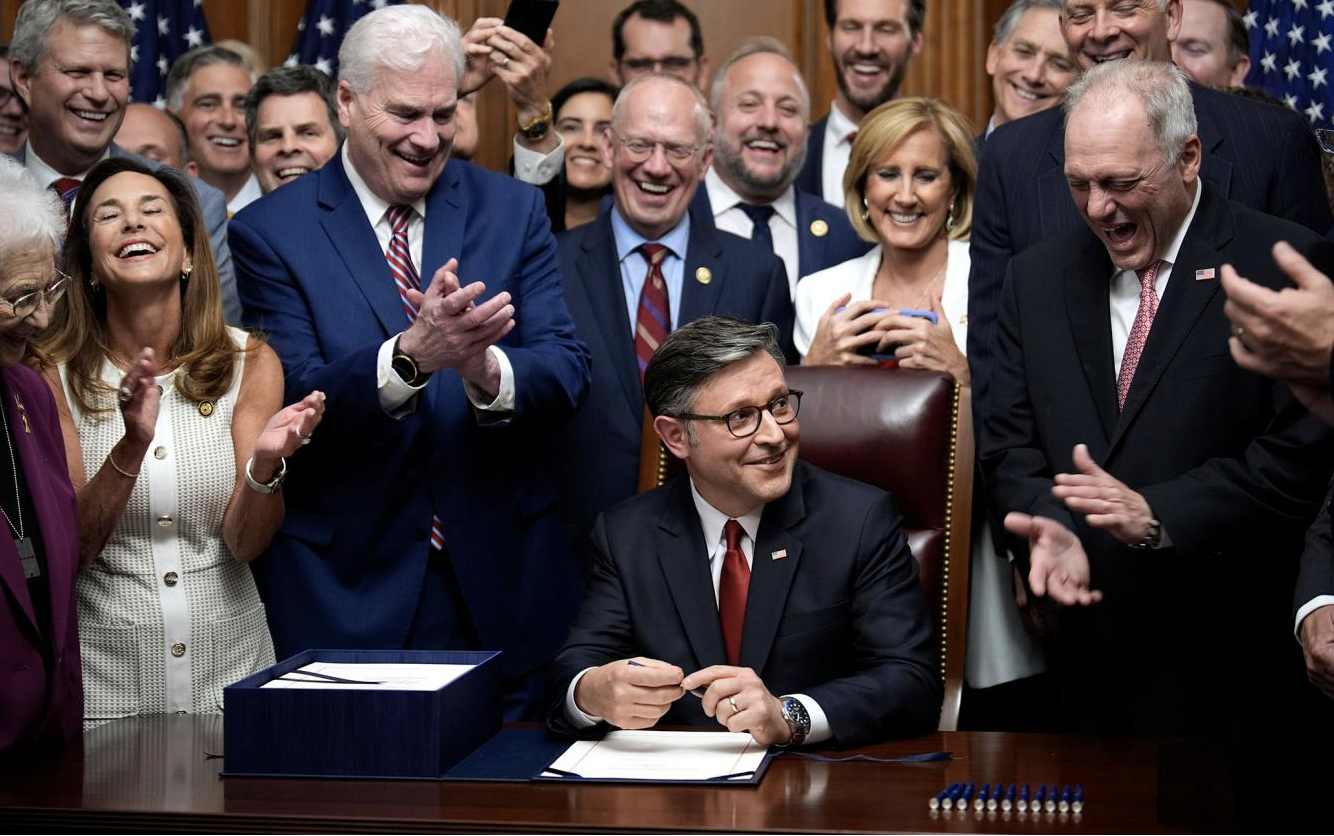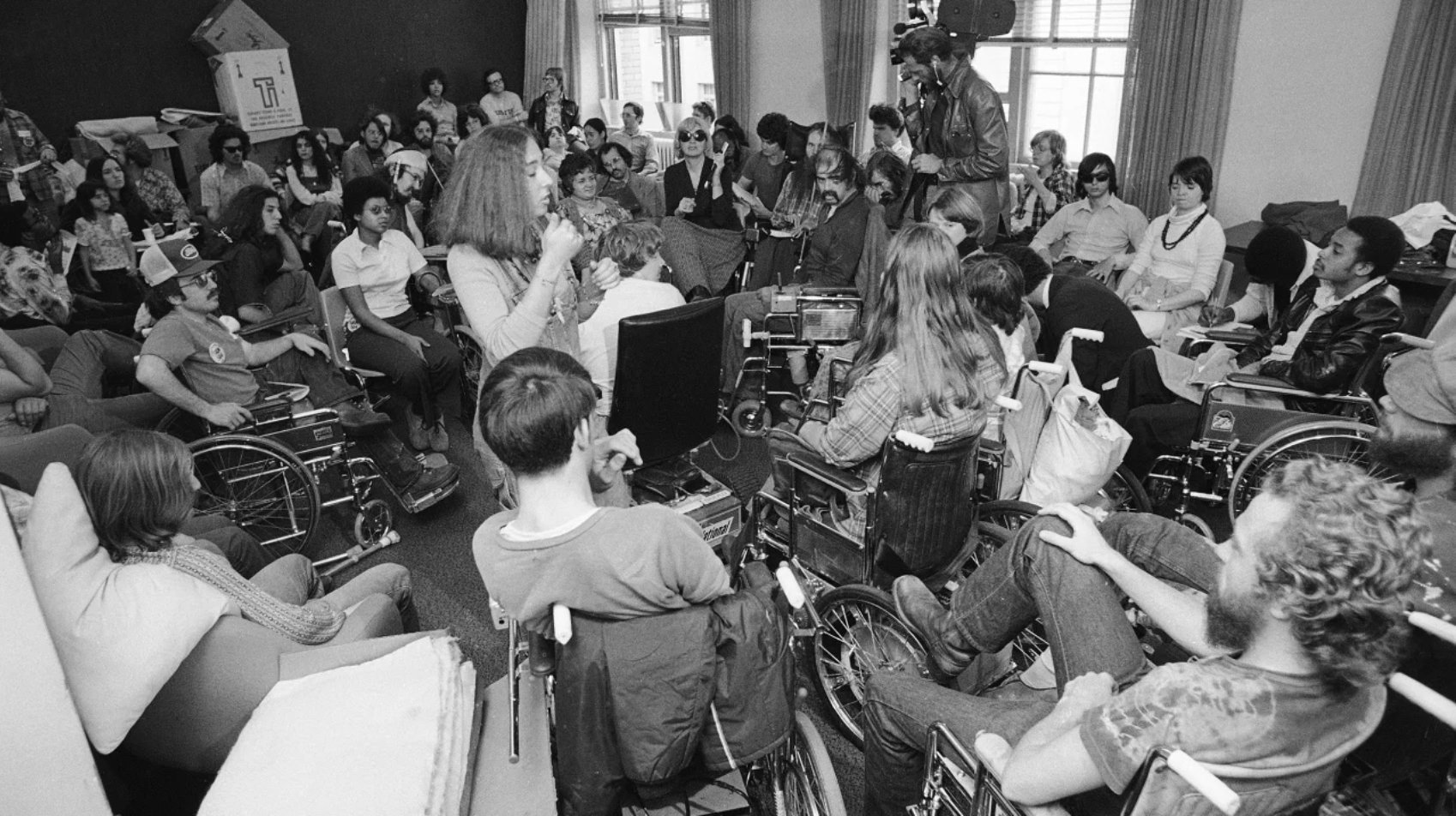Protecting Our Rights: Why Advocacy Is Never Finished
Image: People gather for Disability Pride rally in New York in July 2015.
Each generation of the disability rights movement has worked hard, through advocacy and other efforts, to ensure basic rights for people with disabilities in the areas of equality, equity, access, and independence. From Section 504 to the ADA to the community-based living victories of Olmstead v. L.C., progress has always depended on people speaking up, organizing, and bringing their voices to decision-makers.
We are fortunate today to have many rights, services, and programs that support independent living. Even so, history shows that landmark victories and basic rights we’ve come to expect can be diluted or even reversed. Changes in funding, policy, politics, and more, if ignored or met with silence, can result in losing some of our rights and benefits. It’s important that we stay informed, not only of what’s happening right now, but also about critical points in history that we can learn from and build upon.
We’ll look at some examples of current areas that may be threatened, and some historical examples of how we’ve worked through times like this to preserve fundamental independent living resources and rights.
When Progress Feels Secure, That’s When It’s Most Vulnerable
Today, we are again reminded that rights and programs people rely on are not guaranteed. During recent federal budget negotiations and the current shutdown, advocacy groups such as The Arc and Disability Rights Florida warned that even temporary disruptions could delay Social Security and SSI appeals, pause essential casework, and weaken enforcement of civil-rights protections. For many, these are lifelines that determine whether someone receives medical care, accessible housing, or daily supports.
Image: House Speaker Mike Johnson, with Republican leaders, signs the "One Big Beautiful Bill Act" on Capitol Hill in Washington on Thursday, July 3, 2025. (Photo: Yuri Gripas/Abaca Press/TNS)
Reports from organizations such as the Center for American Progress and the American Bar Association have detailed how recent regulatory actions have slowed or weakened the enforcement of disability rights laws. In 2025, the U.S. Department of Justice rescinded 11 long-standing ADA guidance documents that were used by businesses and local governments to interpret accessibility requirements, a move that advocacy groups say creates confusion and reduces accountability. The Department of Labor has also proposed removing the 7 percent utilization goal that encouraged federal contractors to employ approximately 7 percent of their workforce by people with disabilities, reducing transparency around workforce inclusion.
At the same time, administrative efforts to dismantle diversity, equity, inclusion, and accessibility (DEIA) offices within federal agencies have undercut the infrastructure that ensures ADA compliance across departments. In some cases, agencies have fast-tracked rule changes or reduced public-input opportunities on disability-related regulations, limiting the very community participation that the Independent Living movement helped establish decades ago. Learn more here.
These domestic policy shifts mirror a broader global trend: when budgets tighten or priorities change, disability and social programs are often among the first to face cuts. In 2025, Congress approved proposals to reduce Medicaid funding by nearly $1 trillion, threatening home- and community-based services that allow people with disabilities to live independently. Analysts from the Center for American Progress warn that such reductions could force states to scale back or eliminate “optional” supports such as personal care, therapies, and independent-living assistance.
At the same time, federal funding freezes have led to layoffs and the loss of vital programs, including the 2025 termination of the SOAR (SSI/SSDI Outreach, Access, and Recovery) initiative, which had helped thousands of people with disabilities access Social Security benefits.
Each of these examples underscores how progress can quietly erode long before rights are formally repealed, and why sustained awareness and advocacy remain essential to protect independence, access, and equality.
Lessons From History: Defending and Expanding Our Rights
The struggle to protect and advance disability rights is not new. It has been fought again and again whenever protections were threatened.
Image: Activists gather for the 504 Sit-in in California in 1973
In 1979, a small group of disability rights activists and attorneys gathered in Berkeley, California. Many of them were veterans of the Independent Living movement. They formed what would become one of the nation’s most influential legal advocacy organizations: the Disability Rights Education and Defense Fund (DREDF). Co-founded by Mary Lou Breslin, Patrisha Wright, and Robert Funk, DREDF grew out of the energy and organizing that had surrounded the 504 Sit-Ins just a few years earlier. Those demonstrations had forced the federal government to issue long-delayed regulations for Section 504 of the Rehabilitation Act of 1973, the first federal law to prohibit discrimination based on disability. To learn more about the 504 sit-in, read this previous article.
Yet by the late 1970s, as federal agencies under new political leadership began signaling efforts to roll back or weaken Section 504, Breslin, Wright, and others saw an urgent need for a dedicated legal and policy center that could defend those hard-won gains. Meeting in borrowed office space in Berkeley and drawing on the grassroots power of the Independent Living movement, they launched DREDF on October 1, 1979. The organization quickly became a hub for legal expertise, training, and education, mobilizing advocates across the country, briefing legislators, and providing direct legal defense to ensure that 504’s protections remained intact.
DREDF’s work during this critical period not only preserved the integrity of Section 504 but also laid the foundation for future disability rights legislation. Their coalition-building, policy research, and legal strategy directly influenced the drafting and passage of the Americans with Disabilities Act (ADA) a decade later, turning the energy of grassroots activism into an enduring civil rights law.
Two decades after those victories, another defining case reaffirmed the same principle in a new context: the right to live in the community.
In the early 1990s, two women from Georgia, Lois Curtis and Elaine Wilson, were confined in the state-run Georgia Regional Hospital at Atlanta, a psychiatric and developmental disability institution. Both women had intellectual and psychiatric disabilities, but their treating professionals determined that they were capable of, and would benefit from, living in community-based settings with proper supports. Despite these medical clearances, the state refused to provide the necessary community services or help them transition out.
Their confinement was not due to any medical need. It was a bureaucratic and funding issue. Georgia, like many states at the time, prioritized institutional care over community supports, leaving thousands of people effectively trapped in hospitals and nursing facilities simply because of how services were funded.
Image: Lois Curtis and Elaine Wilson stand in front of the Supreme Court building. Photo: Tom Olin – Tom Olin Collection
Lois Curtis, with the help of the Atlanta Legal Aid Society and attorney Sue Jamieson, filed suit against the State of Georgia under the Americans with Disabilities Act (ADA). Elaine Wilson later joined as a co-plaintiff. Together, their case, Olmstead v. L.C. (1999), reached the U.S. Supreme Court.
In a landmark 6–3 decision, the Court ruled that unjustified segregation of people with disabilities is a form of discrimination under Title II of the ADA. The Court held that individuals with disabilities have the right to receive services in the most integrated setting appropriate to their needs, meaning that states must provide opportunities for community living when it is medically appropriate, and when resources can reasonably accommodate it.
The Olmstead decision became a cornerstone of the Independent Living and disability rights movements. It affirmed what advocates had been saying for decades: that institutionalization, even under the guise of care, can be a form of discrimination. It gave legal weight to the principle that people with disabilities should have the freedom to live, work, and participate fully in their communities.
Yet, like Section 504 before it, Olmstead has required ongoing defense and enforcement. In the years since, advocates and legal organizations such as the Disability Rights Education and Defense Fund (DREDF), the Bazelon Center for Mental Health Law, and the National Council on Independent Living (NCIL) have continued to push states to fulfill their obligations under the ruling. Many still fail to provide sufficient funding for home- and community-based services (HCBS), leaving individuals at risk of unnecessary institutionalization.
Today, Olmstead stands as both a legal precedent and a moral compass — a reminder that independence is not merely a programmatic goal, but a civil right.
The lesson from both DREDF’s fight for 504 and the Olmstead case is clear: even when the law is on our side, the work of enforcement and implementation never ends. And this requires awareness and advocacy from everyday people like us, some of whom will go on to lead the next efforts to support and protect independent living rights.
Awareness Is the First Step — Action Must Follow
For those of us in the Independent Living movement, this history is both a warning and an inspiration. The rights, services, and supports we rely on today exist because people before us refused to stay silent, and they will continue to exist only if we do the same.
The policies and proposals shaping the future of disability rights are not abstract. They affect whether people can remain in their homes with proper care, whether children can receive accessible education, and whether our communities stay inclusive and equitable. When we lose vigilance, rights begin to erode quietly, not in sweeping announcements, but in the slow disappearance of programs, funding, and oversight.
That’s why advocacy cannot be an occasional act; it has to be a habit of citizenship. We are living in another defining moment where awareness, education, and organized action matter more than ever.
Advocacy can take many forms:
Stay informed. Follow updates from organizations such as the Center for American Progress, Disability Rights Florida, The Arc, and DREDF. Sign up for Advocacy updates through CPWD’s advocacy program here. Pay attention to how proposed federal and state budget changes affect Medicaid, housing, or employment programs.
Speak up locally. Contact legislators when disability rights are threatened or underfunded. Even one letter, call, or testimony can make a difference in how policy is shaped.
Vote — and help others vote. Access to the ballot box is part of access, period. Voting is one of the most direct ways to defend the programs and laws that uphold Independent Living.
Share your story. When people understand how these programs change lives, how a ramp made independence possible, or how a home aide allowed someone to stay in their community, they begin to see policy not as politics, but as humanity.
Support Independent Living centers. Centers like the CPWD depend on community engagement and advocacy to continue providing services that promote autonomy and inclusion.
Every major step forward, from Section 504 to the ADA to Olmstead, began because people refused to stay silent. Today’s challenges demand the same courage.
The Independent Living movement was never about pity or pittance; it was about equality and inclusion. Having a seat at the decision-making table, having our voices heard, and impressing upon others the critical importance of rights and benefits requires participation. As we face a future of shifting priorities and uncertain budgets, we must ensure that our hard-won rights are protected — not only for ourselves, but for the generations to come.
Join CPWD’s Advocacy Work
If you want to be part of protecting and advancing disability rights in Colorado, you can connect directly with CPWD’s advocacy team. CPWD actively engages in local, state, and national policy work to promote inclusion, accessibility, and the principles of Independent Living.
Learn more about how you can get involved, receive advocacy updates, or participate in public policy initiatives by visiting our Advocacy page (button will be below)
Whether it’s testifying at a hearing, writing to your representatives, or joining community events, your voice matters. Together, we can ensure that independence, access, and equality remain not just words in our history, but commitments in our future.





